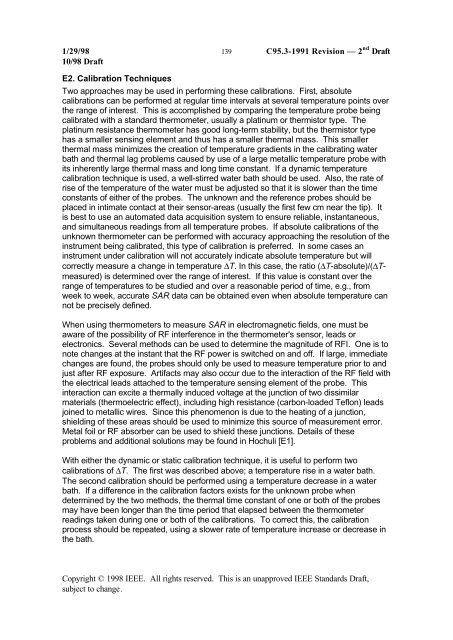DRAFT Recommended Practice for Measurements and ...
DRAFT Recommended Practice for Measurements and ...
DRAFT Recommended Practice for Measurements and ...
You also want an ePaper? Increase the reach of your titles
YUMPU automatically turns print PDFs into web optimized ePapers that Google loves.
1/29/98 139 C95.3-1991 Revision — 2 nd Draft<br />
10/98 Draft<br />
E2. Calibration Techniques<br />
Two approaches may be used in per<strong>for</strong>ming these calibrations. First, absolute<br />
calibrations can be per<strong>for</strong>med at regular time intervals at several temperature points over<br />
the range of interest. This is accomplished by comparing the temperature probe being<br />
calibrated with a st<strong>and</strong>ard thermometer, usually a platinum or thermistor type. The<br />
platinum resistance thermometer has good long-term stability, but the thermistor type<br />
has a smaller sensing element <strong>and</strong> thus has a smaller thermal mass. This smaller<br />
thermal mass minimizes the creation of temperature gradients in the calibrating water<br />
bath <strong>and</strong> thermal lag problems caused by use of a large metallic temperature probe with<br />
its inherently large thermal mass <strong>and</strong> long time constant. If a dynamic temperature<br />
calibration technique is used, a well-stirred water bath should be used. Also, the rate of<br />
rise of the temperature of the water must be adjusted so that it is slower than the time<br />
constants of either of the probes. The unknown <strong>and</strong> the reference probes should be<br />
placed in intimate contact at their sensor-areas (usually the first few cm near the tip). It<br />
is best to use an automated data acquisition system to ensure reliable, instantaneous,<br />
<strong>and</strong> simultaneous readings from all temperature probes. If absolute calibrations of the<br />
unknown thermometer can be per<strong>for</strong>med with accuracy approaching the resolution of the<br />
instrument being calibrated, this type of calibration is preferred. In some cases an<br />
instrument under calibration will not accurately indicate absolute temperature but will<br />
correctly measure a change in temperature ∆T. In this case, the ratio (∆T-absolute)/(∆Tmeasured)<br />
is determined over the range of interest. If this value is constant over the<br />
range of temperatures to be studied <strong>and</strong> over a reasonable period of time, e.g., from<br />
week to week, accurate SAR data can be obtained even when absolute temperature can<br />
not be precisely defined.<br />
When using thermometers to measure SAR in electromagnetic fields, one must be<br />
aware of the possibility of RF interference in the thermometer's sensor, leads or<br />
electronics. Several methods can be used to determine the magnitude of RFI. One is to<br />
note changes at the instant that the RF power is switched on <strong>and</strong> off. If large, immediate<br />
changes are found, the probes should only be used to measure temperature prior to <strong>and</strong><br />
just after RF exposure. Artifacts may also occur due to the interaction of the RF field with<br />
the electrical leads attached to the temperature sensing element of the probe. This<br />
interaction can excite a thermally induced voltage at the junction of two dissimilar<br />
materials (thermoelectric effect), including high resistance (carbon-loaded Teflon) leads<br />
joined to metallic wires. Since this phenomenon is due to the heating of a junction,<br />
shielding of these areas should be used to minimize this source of measurement error.<br />
Metal foil or RF absorber can be used to shield these junctions. Details of these<br />
problems <strong>and</strong> additional solutions may be found in Hochuli [E1].<br />
With either the dynamic or static calibration technique, it is useful to per<strong>for</strong>m two<br />
calibrations of ∆T. The first was described above; a temperature rise in a water bath.<br />
The second calibration should be per<strong>for</strong>med using a temperature decrease in a water<br />
bath. If a difference in the calibration factors exists <strong>for</strong> the unknown probe when<br />
determined by the two methods, the thermal time constant of one or both of the probes<br />
may have been longer than the time period that elapsed between the thermometer<br />
readings taken during one or both of the calibrations. To correct this, the calibration<br />
process should be repeated, using a slower rate of temperature increase or decrease in<br />
the bath.<br />
Copyright © 1998 IEEE. All rights reserved. This is an unapproved IEEE St<strong>and</strong>ards Draft,<br />
subject to change.
















